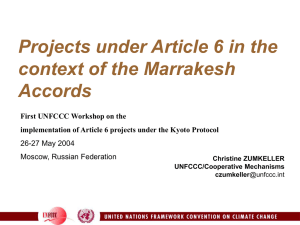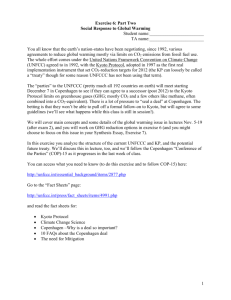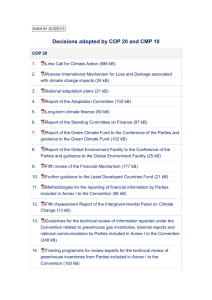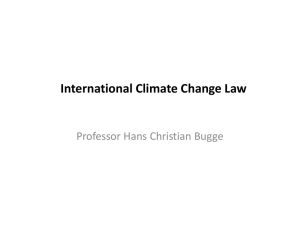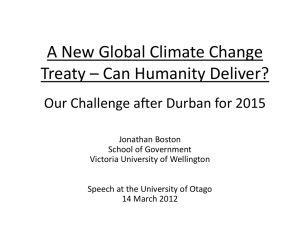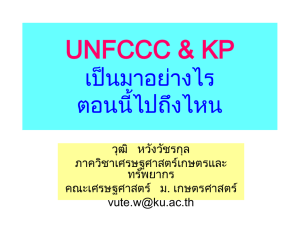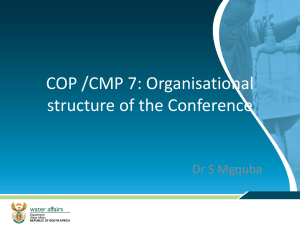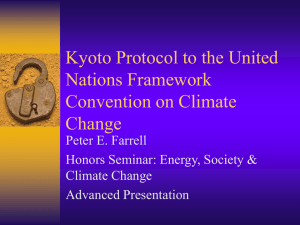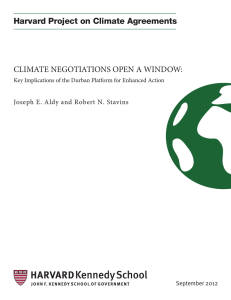3. International Climate Regime
advertisement
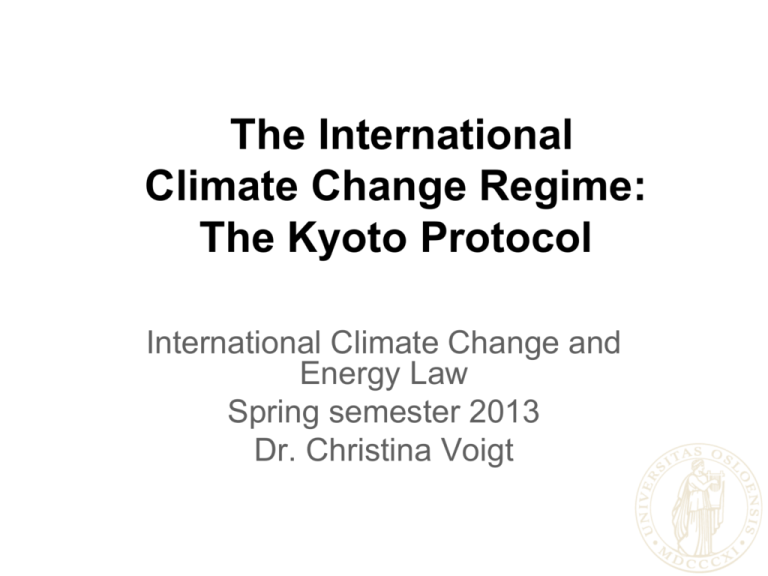
The International Climate Change Regime: The Kyoto Protocol International Climate Change and Energy Law Spring semester 2013 Dr. Christina Voigt Quiz 1. Which legally binding international agreements exists in the field of climate change? 2. Where do we find the ultimate objective of the UNFCCC? 3. What are ”Annex-I countries”? 4. What are ”non-Annex countries”? 5. What is the COP? 2 Institutional Structure UNEP/WHO COP, art. 7 Secretariat Art. 8 UNFCC, 14 KP UNFCCC IPCC CMP, art. 13 KP KP SBSTA SBI Art. 9 UNFCCC Art. 10 Annex I: OECD + EiT (AWG-LCA) ADP Annex II: OECD Non-Annex: developing countries Groups: EU Umbrella: USA, CAN, NO, AUS, NZ, RF, UK G77 and China (subgroups: AOSIS and LDC, African Group) EIG: Sveits, MX, South Korea OPEC BASIC: Brazil, India, China, South Africa CDM EB Art. 12 KP JISC Art. 6 Compliance Committee art. 18 KP Facilitative EnforceBranch ment Branch (AWG-KP) UNFCCC Stronger commitments needed! …. Art. 17: Protocol necessary (more specific obligations) Kyoto Protocol - CPI • Entered into force 16.02.2005, Members: 192 States and the EU • Sets quantified emissions limitation and reduction obligations (QELRO) for Annex-I Parties (37 States) • Art. 3.1 KP: overall emissions from Annex I Parties shall be reduced to at least 5% below 1990 levels within 2008-2012 (First Commitment Period) • Assigned Amounts (Annex B) • Art. 3.1 KP: Annex I Parties shall not exceed their Assigned Amounts) Kyoto Protocol Countries included in Annex B to the Kyoto Protocol and their emissions targets Country Target (1990- 2008/2012) EU-15, Bulgaria, Czech Republic, Estonia, Latvia, Liechtenstein, Lithuania, Monaco, Romania, Slovakia, Slovenia, Switzerland -8% US -7% Canada, Hungary, Japan, Poland -6% Croatia -5% New Zealand, Russian Federation, Ukraine 0 Norway +1% Australia +8% Iceland +10% Kyoto Protocol • Rules focus on: • Commitments: legally binding individual emissions targets and general commitments • Implementation: domestic masures and three novel implementing mechanisms (flexibility mechanisms) • Minimizing impacts on developing countries • Accounting, Reporting and Review • Compliance: Compliance Committee to assess and deal with problems of non-compliance Flexibility Mechanisms • Geographic location of abatement measures is climatically irrelevant • Aim: global cost-effectiveness and reduction of compliance costs • Assigned amounts (AU) can be divided up into units (Assigned Amount Units – AAUs) allowing Annex I Parties (37 + EU) to participate in the flexibility mechanisms • Units create a tradable currency (1 unit= 1 t CO2 eqv.) Flexibility Mechanisms 4 Types of Mechanisms: • Clean Development Mechanism (CDM) Art. 12 • Resulting in Certified Emissions Reductions – CERs • Non-Annex I/ Annex I Projects • Joint Implementation (Art. 6) •Resulting in Emission Reduction Units – ERUs •Annex I /Annex I Projects • International Emissions Trading, Art. 17 (allows for trade with AAUs, ERUs, CERs) • Joint Fulfillment of Commitment (Art. 4) CPII – How did we get there? • What is it?: Doha Amendment pursuant to Art. 3.9 KP, adopted in Doha, December 2013 • First commitment period expired 31.12. 2012 (not the Protocol!) • Developing countries demanded developed countries to continue with the KP (But: USA?) • In Durban 2011: EU plus some other Annex-I countries agreed to a CPII… • …to put pessure on developing countries in the ADP. 10 Kyoto CP II – Second commitment period (2013-2020) for KP Annexcountries, minus CA, RUS, NZL, J – Objective of reducing GHG emissions by at least 18% below 1990 (translation of voluntary pledges into QUELROs – no strengthening of commitments), IPCC suggested range of 25-40%) 15% of global emissions – Party may «propose an adjustment to decrease» its QUELRO, review in 2014 – When does it enter into force? (provisional application/implementation consistent with national legislation or domestic processes) Kyoto CPII – Limit on carry-over of surplus allowances (Russia ca. 13Gt CO2 eq.), political declarations to not purchase CPI surplusses – Participation in the flexibility mechanism (in particular CDM) for non-Parties (but no transfer or aquisition of CERs) ADP ADP: Durban Platform for Enhanced Action a) Etablert av COP 17 i Durban b) Mandat: (1/CP.17) “Also decides to launch a process to develop a protocol, another legal instrument or an agreed outcome with legal force under the Convention applicable to all Parties, through a subsidiary body under the Convention hereby established and to be known as the Ad Hoc Working Group on the Durban Platform for Enhanced Action” and: “Ad Hoc Working Group on the Durban Platform for Enhanced Action shall complete its work as early as possible but no later than 2015 in order to adopt this protocol, legal instrument or agreed outcome with legal force at COP 21 and to enter into force in 2020. Durban Platform • Establishment of a new body to negotiate a global agreement (Ad Hoc Working Group on the Durban Platform for Enhanced Action) by 2015 to come into effect and be implemented from 2020; • The form and substance of a new agreement were not decided • Parties opted for three options - ‘protocol, legal instrument or agreed outcome with legal force’ 14 Legal Form • What is a ”Protocol, another legal instrument or an agreed outcome with legal force under the Convention”? • ”Deal” between the EU (legally binding agreement/commitment) and India (legally binding outcome) • ”outcome with legal force”: not a legal instrument under the UNFCCC: amendment, annex, protocol • Legal force = legally binding or something different? outcome that is not legally binding? COP decision? 15 ADP (after Doha) • Two work streams: increasing ambition before 2020/comprehensive climate agreement in 2020 • Resurfacing of the «Fire-Wall», China: mentioning of equity, CBDRRC and Rio+20/USA: no! • Principles of the Convention apply, but how? • Universality of application but not uniformity of content What Now? • Bridging the Gaps: – Emission Gap (UNEP Emission Gap report: • Implement pledges: 1 Gt • Business as usual: 10 Gt – Legal Gap: When does KP CPII enter into force? Will there be a global agreement by 2015? Will it be legally binding? – Equity Gap: What is equity and who should be doing what? 17 What is Equity, Art. 3 UNFCCC? • Definition: The quality of being fair or impartial; fairness; impartiality • Synonyms: impartiality, fair-mindedness, fairness, justness, evenhandedness, justice, objectivity • In the international discourse: equity and fairness used interchangeably Equity and Equality • Equality of sovereign states is a fundament in Public International Law – Equality: Same rights and duties, no arbitrary discrimination among equals – Problem: States differ! Differentiation and positive discrimination (affirmative action) is necessary in order to treat different states equally. The Principle of Common but Differentiated Responsibilities …..and respective capabilities! • Rio Declaration: “In view of the different contributions to global environmental degradation, States have common but differentiated responsibilities. The developed countries acknowledge the responsibility that they bear in the international pursuit of sustainable development in view of the pressures their societies place on the global environment and of the technologies and financial resources they command.” • Framework Convention on Climate Change; “…parties should act to protect the climate system “on the basis of equity and in accordance with their common but differentiated responsibilities and respective capabilities.” The Principle of Common but Differentiated Responsibilities …..and respective capabilities! • How to interpret in 2013/2015/2020 and beyond? • Based on which criteria should differentiation be made? • Why? • How politically feasible is that? • …and how effective? Top Fossil Fuel Emitters (Absolute) Top four emitters in 2011 covered 62% of global emissions China (28%), United States (16%), EU27 (11%), India (7%) The growing gap between EU27 and USA is due to emission decreases in Germany (45% of the 1990-2011 cumulative difference), UK (19%), Romania (13%), Czech Republic (8%), and Poland (5%) Source: CDIAC Data; Le Quéré et al. 2012; Global Carbon Project 2012 Per capita emissions 23 …and respective capability? The ten largest economies in the world, measured in nominal GDP (millions of USD) Alternative measures of “Responsibility” Depending on perspective, the importance of individual countries changes Cumulative emissions from 1751; Production is also called Territorial; GDP: Gross Domestic Product Source: CDIAC Data; Unstats; Le Quéré et al. 2012; Global Carbon Project 2012 The Principle of Common but Differentiated Responsibilities …..and respective capabilities! • How to interpret in 2013/2015/2020 and beyond? • Based on which criteria should differentiation be made? • Why? • How politically feasible is that? • …and how effective?

